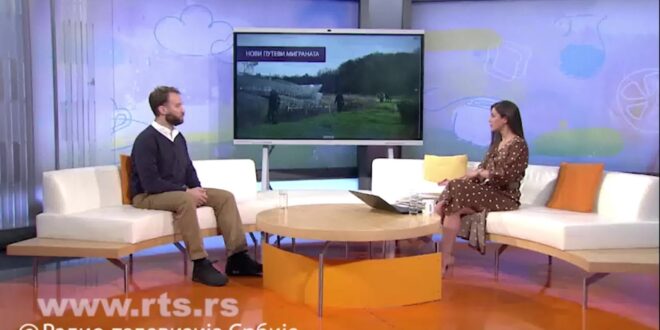Source: RTS
Video: RTS
Belgrade, November 7, 2023– Radoš Đurović from Asylum Protection Center tells RTS that the problem of smuggling gangs and their mutual conflicts in Serbia has been going on for years, and that Serbian citizens are also involved in the conflict. He sees a direct connection between the Hungarian policy of putting up a fence on the border with Serbia and strengthening the influence of smuggling organizations. However, he says there is no link between the new wave of migration and terrorist attacks in Europe.
On November 6, the Serbian police found 165 irregular migrants on the territory of Pirot, Kikinda, Subotica and Sombor. An automatic rifle frame with 30 bullets was also found, and three vehicles and a small sum of money were also taken.
Radoš Đurović from Asylum Protection Center says that in the north of the country there is a “war between smuggling gangs” and that the problem has been present for many years. He states that the conflict culminated in late 2022 and early 2023, through the armed clashes of groups.
“These are organized gangs that are not made up exclusively of representatives from the migrant population of criminals, but also those groups in which our citizens are also involved. They transfer people across the border and take huge amounts of money,” says Đurović.
Đurović: The wall policy is wrong
He points out that the conflicts of smuggling groups take place along the borders of Serbia with Hungary, Croatia and Romania, and that their goal is to control the territory. Đurović also notes a direct connection between the Hungarian policy of building a fence on the border with Serbia and the strengthening of smuggling groups.
“It’s been like that since 2015, when the fence was built up, and since then refugees and immigrants have been flocking to the hands of those who provide them with another attempt to cross the border,” says Đurović.
He also points out that the ultimate goal of the migrants is unchanged, most of them want to go to one of the countries of the European Union (EU).
Đurović states that the majority of refugees are from Afghanistan and Syria, and that Serbia is their last border, or vestibule, towards the EU. Many of them find help right at Asylum Protection Center.
“People want to come to us and use their last efforts – paying smugglers – to get to the EU. Many of them are disoriented and misinformed,” Đurović points out.
There is no connection between terrorist attacks and the latest wave of migration
Radoš Đurović believes that terrorist attacks in Europe have no cause in the most recent wave of migration or with the conflict in the Middle East.
According to him, refugees from Gaza are unlikely to reach the shores of Europe, unless Egypt withdraws its barriers and allows people to leave the Gaza Strip.
“It is difficult to imagine that refugees go through Israel. However, if the entire Middle East enters into a conflict, we can expect a new influx of refugees, primarily in Turkey. The events from Belgium and France are not the same. We are talking about the first, second or third generation of migrants. Many of them are citizens of those countries,” says Đurović.
He says that most EU member states are using populist or short-term goals to stop a process that is timeless. As he points out, terrorism does not come from migration either, stating that terrorist groups are much more seriously organized.
The security situation in the region – politics does not correspond to the nature of migration
Radoš Đurović says that the security situation in the region is not ideal. Slovenia has strengthened security measures at border crossings. Austria and Bosnia and Herzegovina (BiH) raised internal measures to a higher level.
“For me, these are short-term and political goals. They do not influence migration in any way,” Đurović points out.
He also says that migration “does not take place” through the border crossing. Đurović says that Hungary tried to justify its policy of building up fences towards Serbia, and so far one and a half billion euros have been spent, while the results lack and do not correspond to the nature of migration.
 AzilSrbija AzilSrbija
AzilSrbija AzilSrbija





